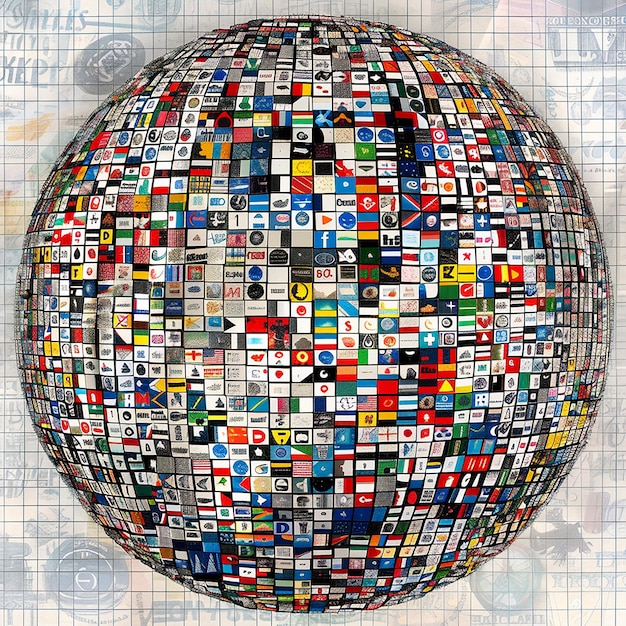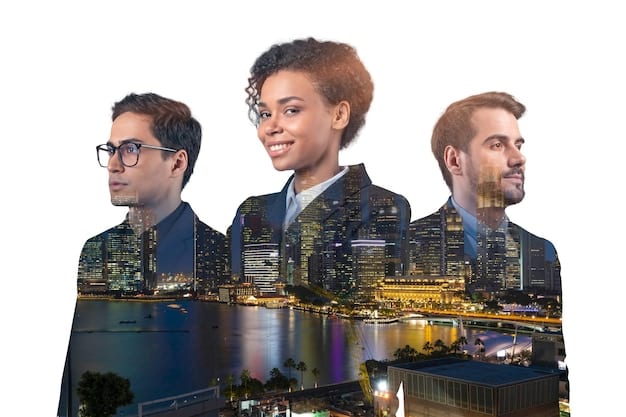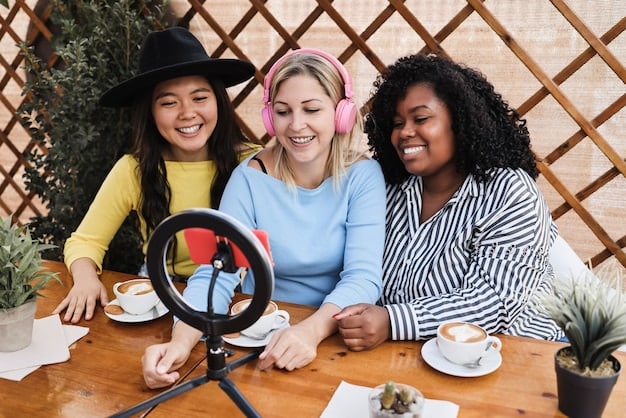Social Media’s Impact: Cultural Narratives in 2025

The Impact of Social Media Algorithms on Cultural Narratives: A 2025 Analysis reveals how these algorithms shape cultural trends, influence societal values, and potentially homogenize or polarize cultural expression within the United States and globally.
The relentless evolution of social media algorithms continues to redefine how we experience and understand culture. In 2025, the Impact of Social Media Algorithms on Cultural Narratives: A 2025 Analysis becomes even more pronounced, shaping everything from the music we listen to to the political ideologies we embrace. How are these algorithms changing us?
Understanding Algorithmic Influence on Culture
Social media algorithms are not neutral arbiters of information; they are complex systems designed to maximize user engagement. This objective has profound consequences for the types of cultural content that gain visibility and traction. In 2025, understanding this dynamic is crucial for anyone seeking to navigate the increasingly algorithmic landscape of cultural expression.
The Echo Chamber Effect
Algorithms often prioritize content that aligns with a user’s existing beliefs and preferences, creating what is known as an echo chamber. This can reinforce existing cultural biases and limit exposure to diverse perspectives.
Trending Topics and Cultural Fads
Algorithms play a significant role in determining what becomes a trending topic, often leading to the rapid spread of cultural fads and memes. This can accelerate cultural change but also contribute to the homogenization of cultural expression.
- Algorithms amplify content that generates strong emotional responses.
- Personalized recommendations shape individual cultural consumption patterns.
- The virality of content influences the perceived importance of cultural narratives.
The prioritization of engagement inevitably shapes the cultural landscape. Algorithms may inadvertently promote sensational or divisive content, undermining more nuanced or thoughtful cultural expression. This calls for a more critical approach to how we consume and interact with online content.

The Rise of Hyper-Personalized Cultural Experiences
In 2025, social media algorithms curate highly personalized cultural experiences. This means users are increasingly exposed to content that aligns with their specific demographic, geographic location, and online behaviors.
Customized Content Streams
Algorithms analyze user data to create customized content streams, ensuring that users are constantly exposed to cultural content that resonates with their interests.
Targeted Advertising and Cultural Consumption
Advertisers leverage algorithms to target specific demographics with culturally relevant campaigns, influencing consumption patterns and shaping cultural trends.
- Algorithms predict cultural preferences based on past behavior.
- Personalized recommendations drive engagement with specific cultural products.
- Targeted advertising amplifies the reach of culturally relevant messaging.
The rise of hyper-personalized cultural experiences raises questions about cultural diversity and inclusivity. While personalization can enhance individual enjoyment, it can also lead to cultural fragmentation and the reinforcement of existing biases.
Cultural Homogenization vs. Polarization
The influence of social media algorithms on cultural narratives can lead to two seemingly contradictory outcomes: cultural homogenization and polarization. Both trends have significant implications for societal cohesion and cultural identity within the United States.
The Spread of Global Cultural Trends
Algorithms facilitate the rapid spread of global cultural trends, exposing users to a wide range of international influences. This can contribute to a more interconnected and globalized cultural landscape.
The Reinforcement of Cultural Divides
At the same time, algorithms can reinforce existing cultural divides by creating echo chambers and amplifying polarizing content. This can exacerbate cultural tensions and undermine social cohesion.
- Algorithms promote content that is likely to generate engagement, regardless of its cultural impact.
- Personalized recommendations can limit exposure to diverse cultural perspectives.
- The virality of content can amplify both positive and negative cultural trends.
The challenge lies in navigating the balance between cultural exchange and cultural preservation. Algorithms have the potential to foster greater understanding and appreciation of diverse cultures, but they can also contribute to the erosion of local cultural identities.
The Role of Influencers in Shaping Cultural Narratives
In 2025, social media influencers continue to play a significant role in shaping cultural narratives. Algorithms amplify the reach of influencers, allowing them to exert considerable influence over cultural trends and consumer behavior.
Authenticity vs. Algorithmic Manipulation
The perceived authenticity of influencers is crucial to their success. However, algorithms can also be manipulated to artificially inflate an influencer’s reach and engagement.
The Ethics of Influencer Marketing
The ethical implications of influencer marketing are becoming increasingly relevant. Concerns about transparency, disclosure, and the potential for misleading consumers are growing.
- Algorithms prioritize content from accounts with high engagement rates.
- Influencers leverage algorithms to reach specific target audiences.
- Brands collaborate with influencers to shape cultural perceptions and trends.
The power of influencers to shape cultural narratives raises questions about accountability and responsibility. Ensuring that influencers are transparent about their affiliations and promoting ethical marketing practices is crucial for maintaining trust and credibility.

Navigating the Algorithmic Cultural Landscape
As algorithms become increasingly sophisticated, it’s vital to develop strategies for navigating the algorithmic cultural landscape. This involves cultivating critical thinking skills, seeking out diverse perspectives, and actively engaging with cultural content.
Cultivating Critical Thinking Skills
Developing critical thinking skills is essential for evaluating the information and cultural content we encounter online. This involves questioning the underlying assumptions, biases, and motivations behind the content.
Seeking Out Diverse Perspectives
Actively seeking out diverse perspectives is crucial for avoiding echo chambers and broadening our understanding of cultural narratives. This involves engaging with content from different cultural backgrounds, viewpoints, and sources.
- Algorithms can be used to filter and prioritize cultural content.
- Personalized recommendations can be customized to promote cultural diversity.
- Users can actively curate their own cultural experiences by seeking out diverse sources.
By becoming more conscious of the influence of algorithms on our cultural experiences, we can take steps to shape our own cultural narratives and promote a more inclusive and equitable cultural landscape.
Policy and Regulation in the Algorithmic Age
Addressing the Impact of Social Media Algorithms on Cultural Narratives: A 2025 Analysis will likely require policy and regulation. Governments and regulatory bodies are increasingly focused on addressing the potential harms associated with algorithmic amplification, including cultural homogenization, polarization, and the spread of misinformation.
Data Privacy and Algorithm Transparency
Policies aimed at protecting data privacy and promoting algorithm transparency are essential for ensuring that algorithms are used responsibly and ethically. This involves requiring companies to disclose how their algorithms work and providing users with greater control over their data.
Promoting Cultural Diversity and Inclusivity
Regulatory measures can be implemented to promote cultural diversity and inclusivity in the algorithmic landscape. This may involve requiring algorithms to prioritize diverse cultural content and preventing the amplification of hate speech or discriminatory content.
- Governments can establish regulatory frameworks for algorithmic accountability.
- Industry standards can be developed to promote responsible algorithmic practices.
- Civil society organizations can advocate for policies that protect cultural diversity and inclusivity.
The development of effective policy and regulation in the algorithmic age requires collaboration between governments, industry, and civil society. By working together, we can create a framework that fosters innovation while mitigating the potential harms associated with algorithmic amplification and its effect on cultural narratives.
| Key Aspect | Brief Description |
|---|---|
| 💡 Algorithmic Influence | Algorithms shape cultural trends by prioritizing engagement. |
| 📱 Hyper-Personalization | Customized content streams reinforce existing cultural biases. |
| 🌐 Cultural Dynamics | Algorithms can lead to both cultural homogenization and polarization. |
| 📢 Influencer Role | Influencers shape cultural narratives, raising questions about ethics. |
Frequently Asked Questions
▼
Algorithms prioritize content based on engagement metrics, influencing what cultural content gains visibility. This can lead to certain narratives being amplified while others are marginalized.
▼
The echo chamber effect occurs when algorithms prioritize content aligning with a user’s existing beliefs. This can limit exposure to diverse cultural perspectives and reinforce biases.
▼
By cultivating critical thinking skills, seeking out diverse perspectives, and actively curating their online experiences, individuals can navigate the algorithmic cultural landscape more effectively.
▼
Influencers leverage algorithms to reach a broader audience, shaping cultural trends and consumer behavior. Their perceived authenticity is crucial, but ethical considerations are increasingly relevant.
▼
Policies focused on data privacy, algorithm transparency, and the promotion of cultural diversity are being considered to address algorithmic harms, fostering responsible and ethical practices.
Conclusion
In conclusion, the impact of social media algorithms on cultural narratives: a 2025 analysis reveals a complex interplay between technology, culture, and society. Understanding the influence of these algorithms is essential for promoting a more diverse, equitable, and culturally rich future.





